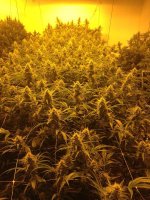Picarus
Member
Not sure if this is the appropriate place to ask a question about lab results but I am in need of some clarification. I have been getting my flowers tested for about a year now. Having numerical data sets to compare to perceived effects has be very enlightening, but I am still having trouble fulling understanding the data.
First, THC delta-9
Merit is given to THC content as a whole but very little is given to delta-9 THC which is the psychoactive element, allegedly. Can anyone explain the merit of the delta-9 THC to me. I believe it is more important than the total THC content. I feel a stronger effect when more delta-9 is present even if the total THC is lower between varieties.
Second, terpenes and flavors
I believe some confusion is starting as terpenes gain notoriety. Terpenes and flavor are connected but not the same. I have two samples, two phenotypes of the same variety, Kosher Kush bx. The lab results concerning terpenes are almost identical with only small variance in total concentration, but the same terpenes are present in the same ratios in both samples. The two samples have similar smells but the taste sets them apart. One is distinctly citrus and the other is woody and exotic, no citrus at all. Yet the limonene terpene level is the same amongst the two. Could terpenes attribute more to smell and less to actual taste? Obviously some will burn off more quickly than others with lower boiling point and other chemical attributes.
I also have experienced that one of my best tasting, I mean stick in your mouth flavor, and smelling flowers is incredibly low in terpene concentration and has no outliers to speak of. How is this explained?
There must be other mechanisms at work here conctributing flavors and smells.
The result of this is people who don't lab test their flowers claiming things about terpene concentrations based on their taste and smell experience, which is still important, but is not actually related to the terpenes, which do actually have their own benefits.
Any help or insight is appreciated!
attached is Ghost Train Haze #1 which tested at 1.66% total terpinolene alone!
First, THC delta-9
Merit is given to THC content as a whole but very little is given to delta-9 THC which is the psychoactive element, allegedly. Can anyone explain the merit of the delta-9 THC to me. I believe it is more important than the total THC content. I feel a stronger effect when more delta-9 is present even if the total THC is lower between varieties.
Second, terpenes and flavors
I believe some confusion is starting as terpenes gain notoriety. Terpenes and flavor are connected but not the same. I have two samples, two phenotypes of the same variety, Kosher Kush bx. The lab results concerning terpenes are almost identical with only small variance in total concentration, but the same terpenes are present in the same ratios in both samples. The two samples have similar smells but the taste sets them apart. One is distinctly citrus and the other is woody and exotic, no citrus at all. Yet the limonene terpene level is the same amongst the two. Could terpenes attribute more to smell and less to actual taste? Obviously some will burn off more quickly than others with lower boiling point and other chemical attributes.
I also have experienced that one of my best tasting, I mean stick in your mouth flavor, and smelling flowers is incredibly low in terpene concentration and has no outliers to speak of. How is this explained?
There must be other mechanisms at work here conctributing flavors and smells.
The result of this is people who don't lab test their flowers claiming things about terpene concentrations based on their taste and smell experience, which is still important, but is not actually related to the terpenes, which do actually have their own benefits.
Any help or insight is appreciated!
attached is Ghost Train Haze #1 which tested at 1.66% total terpinolene alone!





